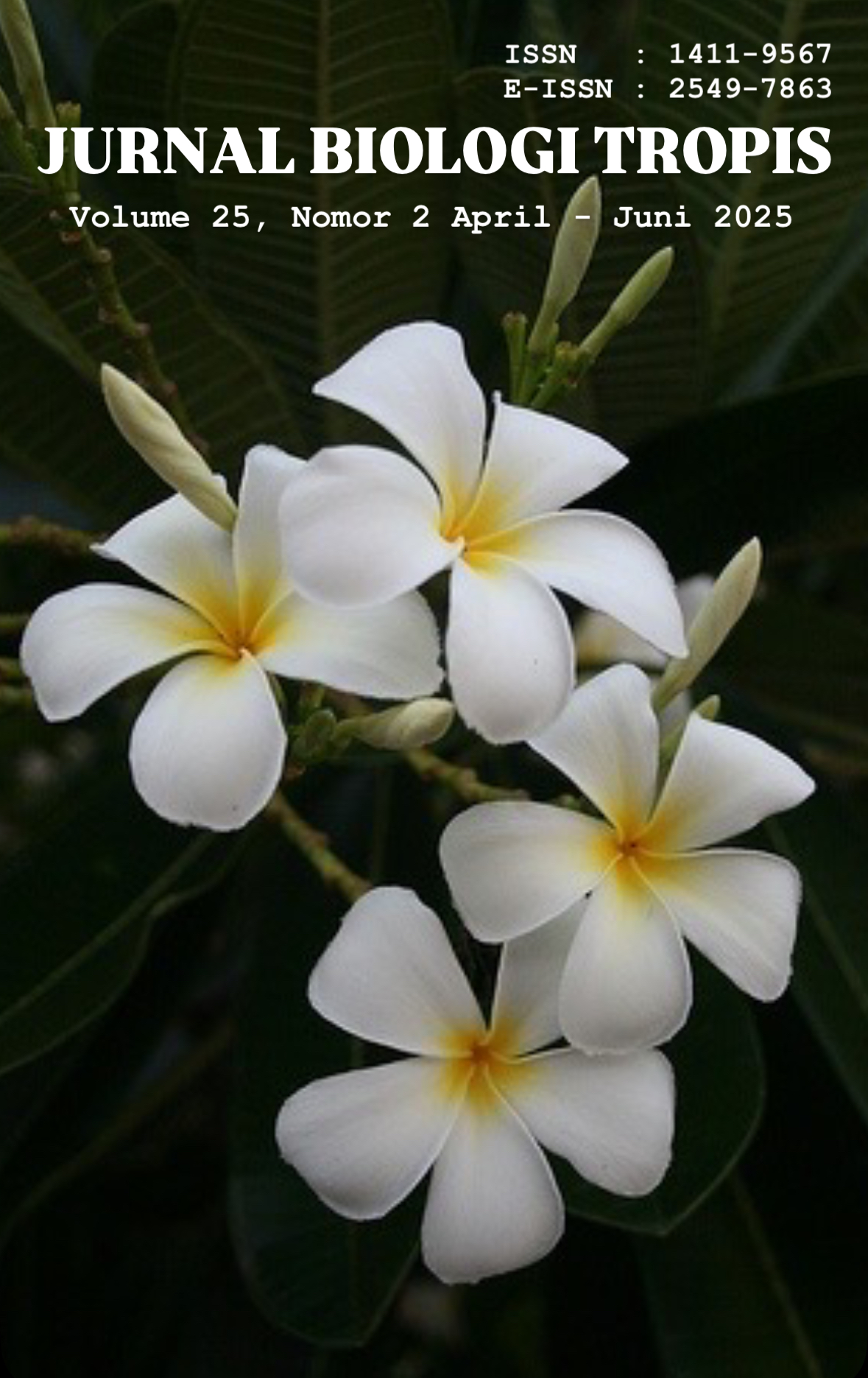A DNA Barcoding Multilocus Analysis in the Cucurbitaceae Family
Authors
Nurbaiti Nurbaiti , Dewi Roslim , Herman HermanDOI:
10.29303/jbt.v25i2.8702Published:
2025-04-20Issue:
Vol. 25 No. 2 (2025): April-JuniKeywords:
Cucurbitaceae, matK, rbcL, ITS, trnL-F IGS.Articles
Downloads
How to Cite
Downloads
Metrics
Abstract
The Cucurbitaceae family is a very diverse family of angiosperms and is often used as a traditional medicine because it produces secondary metabolites in the form of Cucurbitacin B, D, E, and I. The identification and determination of filogeny between species in the Cucurbitaceae family using a single DNA barcode locus is still inefficient. The purpose of this study is to analyze the appropriate and effective combination of DNA barcode multiloci for species identification from the Cucurbitaceae family. The materials used in this study are the database ofns matK, rbcL, ITS and trnL-F IGS from the Cucurbitaceae Family and the outgroup, namely Tetrameles nudiflora which was explored from Genbank through the NCBI website, and then performed MSA (Multiple Sequence Alignment) using MAFFT v.7 software. and sequence editing using Bioedit v.7.2. then DNA sequence analysis and phylogenetic tree construction using MEGA 11. The results show that the ITS locus is the most efficient barcode to identify and distinguish species in the Cucurbitaceae family. The combination of multiloci of the ITS, matk, and trnL-trnF IGS also has the potential to identify and differentiate species in the Cucurbitaceae family on the condition that ITS must be included (be the main locus) and not include rbcL because of its low variability.
References
Adimaka, N., Rifki, M., Dewanti, R., & Cahyadi, M. (2019). Keragaman genetik puyuh Jepang (Coturnix japonica) berdasarkan analisis sekuen DNA mitokondria gen Cytochrome-b. Jurnal Ilmu-Ilmu Peternakan, 29(2), 143–151. https://doi.org/10.21776/ub.jiip.2019.029.02.05
Almeida, A., Dong, L., Thorsen, T.H., Raadam, M.H., Khakimov, B., Quintero, C.N., Kampranis, S.C., & Bak, S. (2022). Metabolic engineering of cucurbitacins in Cucurbita pepo hairy roots. Frontiers inPlant Science, 13(1), 1-18. https://doi.org/10.3389/fpls.2022.1021907
Balladona, F.K., Maskromo, I., Sukma, D., & Sudarson. (2020). Pengembangan penanda molekuler berdasarkan situs SNP dan indel genom kloroplas kelapa. Jurnal Agronida, 6(1), 1-13. https://doi.org/10.30997/jag.v6i1.2548
Filiz, E., Uras, M.E., Ozturk, N., Gungor, H., & Ozyigit, I.I. (2024). Genetic diversity and phylogenetic analyses of Turkish sweet corn ish sweet corn (Zea mays var. saccharata) varieties using ISSR markers) varieties using ISSR markers and chloroplast trnL-F IGS region. Notulae Botanicae Horti Agrobotanici Cluj-Napoca, 52(2), 1-14. https://doi.org/10.15835/nbha52213551
Furan, M.A. (2023). Elevating thyme species identification: exploiting key chloroplast genes (matK, rbcL, and psbA-trnH) through DNA barcoding and phylogenetic analysis. Black Sea Journal of Engineering and Science, 6(4), 572-582. https://doi.org/10.34248/bsengineering.1352976
Herna´ndez, E.H.M., & Coronado, A.C.M. (2023). Research article phylogenetic determination of Chenopodium quinoa based on the chloroplast genes rbcL and matK International Journal of Agronomy, 1(1), 1-9. https://doi.org/10.1155/2023/6681851
Hieu, H.K., Minh, N.V., Loi, N.V., & Ha, H.T. (2024). Application of DNA barcode for the genetic analysis and identifying a May nuoc mo species in Quang Nam Province, Central Vietnam. Biodiversitas, 25(8), 3299-3308. https://doi.org/10.13057/biodiv/d250801
Hidayat, T., Saputro, N.W., Khamid, N.B.R., & Bayfurqon, N.F. (2021). First phylogenetic treatment of apple cucumber (Family Cucurbitaceae) from Indonesia utilizing DNA variation of Internal Transcibed Spacer region. Journal of Bioscience, 28(1), 48-53. https://doi.org/10.4308/hjb.28.1.48
Ho, V.T., & Nguyen, M.P. (2020). An in silico approach for evaluation of rbcL and matK loci for DNA barcoding of Cucurbitaceae family. Biodiversity, 21(8), 3879-3885. https://doi.org/10.13057/biodiv/d210858
Jannah, M., Hariri, M.R., Kasiamdari, R.S., & Handayan, N.S.N. (2021). The use of DNA barcoding and phylogenetic analysis to improve identification of Usnea spp. based on ITS rDNA. Journal of Tropical Biodiversity and Biotechnology, 6(1), 1-12. https://doi.org/10.22146/jtbb.58635
Kang, Y., Deng, Z., Zang, R., & Long, W. (2017). DNA barcoding analysis and phylogenetic relationships of tree species in tropical cloud forests. Scientific Reports, 7(1), 1-9. https://doi.org/10.1038/s41598-017-13057-0
Kumar, K., Anjoy, P., Sahu, S., Durgesh, K., Das, A., Tribhuvan, K.U., Sevanthi, A.M., Joshi, R., Jain, P.K., Singh, N.K., Rao, A.R., & Gaikwad, K. (2022). Single trait versus principal component based association analysis for fowering related traits in pigeonpea . Scientifc Reports, 12(1), 1-15. https://doi.org/10.1038/s41598-022-14568-1
Letsiou, S., Madesis, P., Vasdekis, E., Montemurro, C., Rigoriou, M.E., Skavdis, G., Moussis, V., Koutelidakis, A.E., & Tzakos, A.G. (2023). DNA barcoding as a plant identification method. Applied Sciences, 14, 1-10. https://doi.org/10.3390/app14041415
Li, H., Xiao, W., TieTong, Li, Y., Zhang, M., Lin, X., Zou, X., Wu, Q., & Guo, X. (2021). The specifc DNA barcodes based on chloroplast genes for species identifcation of Orchidaceae plants. Scientifc Reports, 11, 1424. https://doi.org/10.1038/s41598-021-81087
Liu, Q., Lin, N., Zhang, D.G., Huang, Z.H., Wang, H.C., Yang, J., Tojibaev, K., Deng, T., & Li, Z.M. (2021). Trichosanthes sunhangii (Cucurbitaceae), a new species from Hubei, China. Phytotaxa, 479(3), 287–294. https://doi.org/10.11646/phytotaxa.479.3.5
Lone, S.A., Hassan, Q.P., & Gupta, S. (2019). Development of DNA barcode for rapid identification of Epimedium elatum (Morren & Decne) from Northwestern Himalayas in India. Journal of Applied Research on Medicinal and Aromatic Plants, 13(1), 1-8. https://doi.org/10.1016/J.JARMAP.2019.100205
Mishra, P., Kumar, A., Nagireddy, A., Shukla, A.K., & Sundaresan, V. (2017). Evaluation of single and multilocus DNA barcodes towards species delineation in complex tree genus Terminalia. PLoS ONE, 12(8), 1-18. https://doi.org/10.1371/journal.pone.0182836
Mulyawan, R.P., Nurhaidha, R.T., & Supriyatna, A. (2023). Identification and benefits of the Cucurbitaceae family at Negeri Labu Lembang Tourist Locatio. International Journal of Engineering, Economic, Social Politic and Government, 1(3), 44-53. https://doi.org/10.26638/ijespg.v1i3.22
Muthi’ah, S.N., & Jannah, M. (2023). In silico phylogenetic analysis of orange species (Citrus spp.) based on ITS sequences. Bio Sains: Jurnal Ilmiah Biologi, 2 (2), 62-66. https://doi.org/10.34005/bio-sains.v2i2.2106
Park, I., Song, J.H., Yang, S., Chae, S., & Moon, B.C. (2021). Plastid phylogenomic data offers novel insights into the taxonomic status of the Trichosanthes kirilowii complex (Cucurbitaceae) in South Korea. Frontiers in Plant Science, 12, 1-15. https://doi.org/10.3389/fpls.2021.559511
Priyadi, A., Asih, N.P.S., & Erlinawati, I. (2022). Reconstructing phylogenies of Alocasia spp. (Araceae) distributed in Indonesia for conservation prioritization: Reconstructing phylogenies of Alocasia spp. (Araceae). Journal of Tropical Life Science, 12(3), 317–323. https://doi.org/10.11594/jtls.12.03.04
Ramesh, G.A., Mathewa, D., Johnb, K.J., & Ravisankarc, V. (2022). Chloroplast gene matK holds the barcodes for identification of Momordica (Cucurbitaceae) species from Indian subcontinent. Horticultural Plant Journal, 8(1), 89-98. https://doi.org/10.1016/j.hpj.2021.04.001
Schwarzkopf, E.J., Motamayor, J.C., & Cornejo, O.E. (2020). Genetic differentiation and intrinsic genomic features explain variation in recombination hotspots among cocoa tree populations. BMC Genomics, 21, 1-16. https://doi.org/10.1186/s12864-020-6746-2
Slipiko, M., Myszczy´nski, K., Buczkowska, K., B˛aczkiewicz, A., Sawicki, J. (2022). Super-mitobarcoding in plant species identification? it can work! the case of leafy liverworts belonging to the genus Calypogeia. International Journal of Moecular Sciences, 23(1), 1-18. https://doi.org/10.3390/ijms232415570
Sumarlina, & Napitupulu, T.S. (2023). Evaluasi Aplikasi dna barcode lokus psbA-trnH pada Genus Momordica. Jurnal Biotek, 1(2), 182-195. https://doi.org/10.24252/jb.v11i2.37914
Wathon, S., Astikaningrum, D., Ardyah, N.P.C., Oktarianti, R., & Senjarini, K. (2023). In silico exploration of the potential barcode DNA in Anopheles sp., a malarian vector from Indonesia. Jurnal Biolokus: Jurnal Penelitian Pendidikan Biologi dan Biologi, 6(1), 96-110. https://doi.org/10.30821/biolokus.v6i1.1749
Yu, J., Wu, X., Liu, C., Newmaster, S., Ragupathy, B., & Kress, W.J. (2021). Progress in the use of DNA barcodes in the identification and classification of medicinal plants. Ecotoxicology and Environmental Safety, 1, 1-7. https://doi.org/10.1016/j.ecoenv.2020.111691
License
Copyright (c) 2025 Nurbaiti Nurbaiti, Dewi Roslim, Herman Herman

This work is licensed under a Creative Commons Attribution 4.0 International License.

Jurnal Biologi Tropis is licensed under a Creative Commons Attribution 4.0 International License.
The copyright of the received article shall be assigned to the author as the owner of the paper. The intended copyright includes the right to publish the article in various forms (including reprints). The journal maintains the publishing rights to the published articles.
Authors are permitted to disseminate published articles by sharing the link/DOI of the article at the journal. Authors are allowed to use their articles for any legal purposes deemed necessary without written permission from the journal with an acknowledgment of initial publication to this journal.


























